Just as the Allies were keen to gather as much information as they could on German rocket and jet technology during World War Two, the Japanese were likewise seeking this very same technology to aid their war effort. Their need was out of desperation, being constantly pounded by Allied bombing raids and rapidly losing territory they too looked towards any available Wunderwaffe (“wonder-weapon”) Germany could provide to try to stem the tide. Following a 1943 demonstration given to Japanese Army and Navy attaches in Germany, the diminutive, yet incredibly fast Messerschmitt Me 163 Komet rocket interceptor was one such weapon they wanted to pursue.
Mitsubishi J8M Shusui / Ki-200
The Mitsubishi J8M1 Shusui (“Autumn Water” which also relates poetically to “Sharp Sword” and the swishing sound a sword makes) was a joint Imperial Japanese Navy and Army project using the Messerschmitt Me 163 as a basis for the design (the army variant was designated Ki-200). The Japanese were meant to licence-build Me 163 variants but getting complete airframes and parts shipped by submarine proved problematic when the Japanese submarine RO-501 Satsuki (ex U-Boat U-1224) carrying a complete airframe and possibly the two sets of sub-assemblies was sunk by Allied ships en route in the Atlantic in May 1944. A second Japanese submarine I-29 Matsu with 3 rocket motors, blueprints and manufacturer manuals onboard made it to Singapore in July 1944 and the cargo was quickly flown to Japan (for redundancy purposes two submarines were used to split the airframe from the motors and manuals with RO-501 departing in March 1944 and I-29 in April 1944).
The Japanese then had to reverse engineer the aircraft using a flight operations manual and other documentation that had been provided under the deal with Germany (they paid Germany a 20 million Reichsmark licence fee for access to this technology! This was approximately $8 million USD). An impressive effort to develop such a radical piece of technology with few physical components to work from!
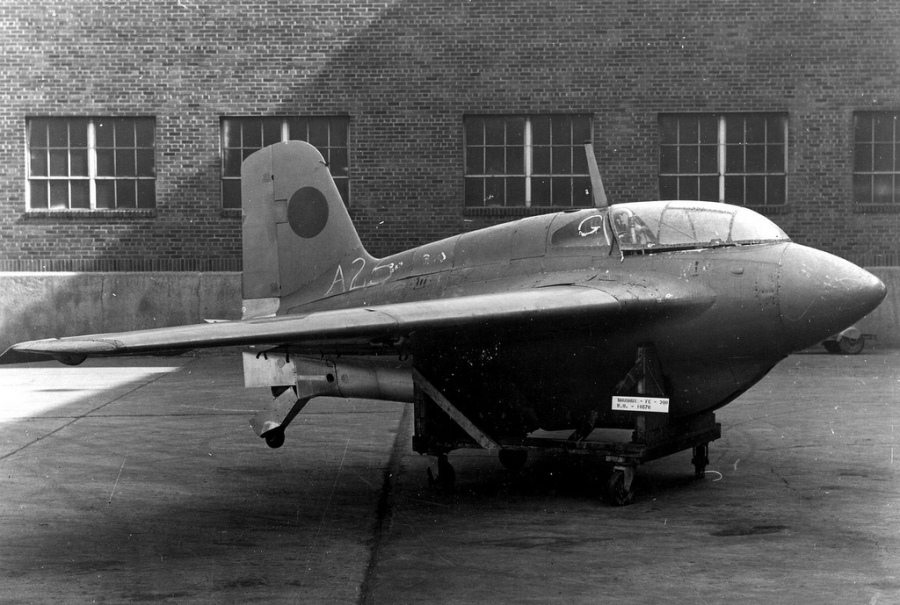
Rocket Motor Development

The Japanese developed their own variant of the German Walter HWK 109-509A rocket motor known as the Toku-Ro.2 (KR10). The motor was constructed using parts built by the Mitsubishi, Hitachi, Ishikawajima and Washimo companies. The first powered motor test did not go well when the prototype engine exploded upon startup (believed to have been a result of the metals used – the Germans used a nickel-chromium alloy in critical parts such as the fuel injector atomizer and regulating/relief valves but this was not available in Japan, so ordinary chromium steel was used instead)!
The Toku-Ro.2 (KR10) was a bi-fuel rocket motor that produced 3,307 lb of thrust which was a little less powerful than the German motor (3,800 lb of thrust). The Japanese rocket motor enabled the J8M1 to reach a maximum speed of 900 km/h (559 mph) which was 59 km/h (37 mph) slower than the Me 163B production model. Regardless, it was still incredibly fast for the day!
Despite the issues experienced in Germany with the Me 163 the Japanese continued with the J8M program and used the same highly volatile German propellants of T-Stoff oxidizer (hydrogen peroxide) and C-Stoff (methanol-hydrazine) to create rocket fuel which was highly explosive, highly corrosive and deadly to touch. They were known as Ko and Otsu in Japanese. The rocket motor basically created propulsion through controlling the explosion that arose when the two types of fuel came into contact with each other!
Like the Me 163 the J8M1/Ki-200 had enough fuel for only a short period of powered flight – around 5.5 minutes for the J8M1 and an estimated 7 minutes for the Ki-200 (based off this estimate, the endurance of the Ki-200 Imperial Japanese Army variant would have been more comparable to the Me 163 but it is difficult to find any hard data on the Ki-200 variant). As with the Me 163, the J8M1 was designed to jettison the undercarriage dolly wheels after take-off and the plan once operational would have been for it to get there fast, hit the Allied bombers hard, then glide back to land on the skid and hopefully get home alive without any explosions (if the volatile fuel was onboard there was always a high risk of explosion, especially during landing)!
Armament & Equipment
The armament of the J8M1 was also modified from the Me 163 to include 2 x 30mm cannons of Japanese origin that had a higher muzzle velocity than the German Mk 108 30mm cannon (540 meters per second). The Imperial Japanese Navy J8M1 was fitted with Type 5 30mm cannons that had a rate of fire of 450 rounds per minute and a muzzle velocity of 720 metres per second. The Imperial Japanese Army Ki-200 variant was fitted with lighter Ho-105 30mm cannons that provided a rate of fire 400 rounds per minute with a muzzle velocity of 750 metres per second.

Japanese radios and batteries were also fitted and although similar in appearance to the Me 163, the airframe of the J8M1 varied slightly to accommodate the different equipment fitted. The J8M1 also did not have the small nose mounted propeller of the Me 163 which was used to power (with a backup battery) onboard systems such as the radio, control circuits etc. (the radio equipment was fitted in this nose space on the J8M1).
Production
7 J8M production aircraft were manufactured by Mitsubishi before the end of World War Two (6 J8M1 and 1 Ki-200, with another six J8M1 in various stages of completion). The variants were the production J8M1/Ki-200 Shusui for the IJN/IJA, plus the planned J8M2 Shusui-Kai variant for the IJN with increased fuel tank capacity for longer range and only 1 x Type 5 30mm cannon, and the planned J8M3/Ki-202 for the IJN/IJA which had an extended fuselage, extended wings and a longer range.
Given the radical leap in performance and handling from traditional piston engine fighter aircraft to a tailless rocket powered interceptor, up to 50 – 60 Kugisho / Yokosuka MXY8 / Ku-13 Akikusa (“Autumn Grass”) wooden glider variants were produced for pilot training and unpowered flight testing. The first glider flew on December 8th, 1944.


The first three J8M1 were completed but lacking a rocket motor by December 1944 (quite fast considering the I-29 submarine only arrived in Singapore in July 1944). Unfortunately the only aircraft prepped for a motor was destroyed, along with the testing centre in a massive 7.9 magnitude earthquake on December 7th, 1944! The remaining aircraft were relocated but increased USAAF bombing raids on industrial locations in December delayed rocket motor development further.
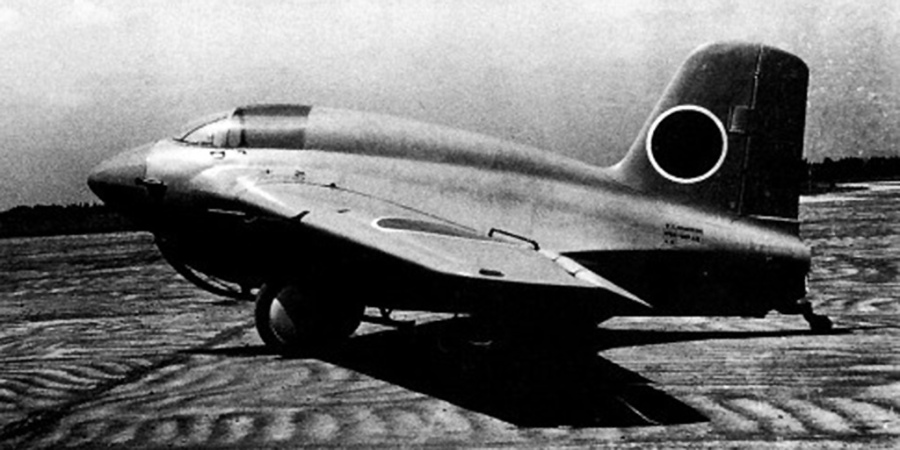
Towed into the sky by an Imperial Japanese Navy Nakajima B6N1 Tenzan “Jill“ torpedo bomber, the first unpowered flight of a Mitsubishi J8M1 Shusui was successfully completed on January 8th, 1945 (the aircraft used was known as a “heavy glider” to differentiate it from the Akikusa gliders). The next crucial step was to make a powered flight.
It was decided that if a rocket motor could achieve sustained power for at least 2 minutes in a test lab, then an actual powered test flight could be conducted. Unfortunately in early 1945 another rocket motor exploded after running for 2 minutes.
These setbacks along with ongoing Allied bombing of the factory locations obviously delayed the production of airframes, rocket motors and the flight test program (ironic given the aircraft was intended to knock bombers out of the sky). For example, out of fear of USAAF B-29 raids, the KR10 rocket motor development team was moved to the Yamakita factory complex in Hakome prefecture and the Mitsubishi Shusui development team was relocated to the Army Matsumoto research and development centre in Nagano prefecture between April and May 1945 – more valuable research and testing time was wasted in the move.
Both teams worked on rocket motors, with the Yamakita team preparing one for the navy J8M1 and the Matsumoto team preparing one for the army Ki-200. By June 1945 the two teams had finally developed a motor that ran for 4 minutes and 3 minutes respectively but a working rocket motor was not available and fitted into a J8M1 for a test flight until July 1945. The second motor was intended to be installed into an army Ki-200.
The First Powered Flight
At Yokuku Airfield, the J8M1 was tethered, ground running test runs were completed and by July 5th, 1945 rocket motor technical difficulties were overcome in the field. Then the first powered flight of the J8M1 was conducted on July 7th, 1945 but ended in tragedy.
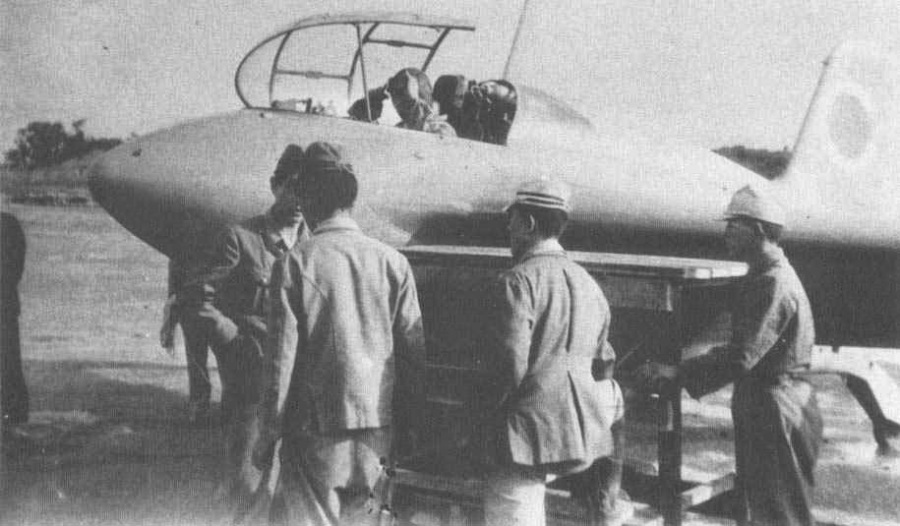
Pilot Lieutenant Commander Toyohiko Inuzuka literally rocketed down the runway, taking off in just 320 metres (1,049 feet). He released the undercarriage dolly and began to climb higher, then unexpectedly the engine cut out. With momentum the J8M1 continued to climb to a height of 500 metres (1,640 feet) before Inuzuka was able to turn back towards the airfield. With air speed dropping he tried to avoid a building but clipped it with a wing and crashed, tearing the aircraft apart upon impact! Miraculously despite still having half of its volatile fuel remaining, it somehow did not explode and burst into flames! The J8M1 was destroyed but Inuzuka had some how survived the crash. His injuries were severe however and he died the following day.

Following investigation it was determined a fuel flow issue caused the rocket motor to cut out. Shortly after the crash 2 more rocket motors exploded on ground testing (one each at Yamakita and Matsumoto), leaving only 1 rocket motor available which was allocated to the Imperial Japanese Army Ki-200. Further motor testing was suspended until the fuel system problem could be resolved. Setback after setback…
Four additional airframes (with another six in various stages of completion) and four more Toku-Ro.2 (KR10) rocket motors were completed (with an additional two almost ready and apparently enough components to make twenty more). The fuel system problems were resolved, with the intention to resume test flights in late August 1945 but one month after the first flight of the J8M1, the atomic bombs “Little Boy” and “Fat Man” were dropped on Hiroshima (August 6th, 1945) and Nagasaki (August 9th, 1945) respectively, by the feared USAAF B-29 bombers (the “Enola Gay” and “Bockscar“).
A few days later Japan agreed to surrender and Japanese representatives formally signed the unconditional surrender document aboard the USS Missouri on September 2nd, 1945. The Ki-200 never made a flight (the rocket motor was not installed) and that was the end of the J8M program (unrealistically the Japanese had apparently planned to produce at least 3,600 J8M/Ki-200 variants by March 1946!).
The Survivors
Only 2 Mitsubishi J8M1 Shusui survive today. 1 is in the United States and the other in Japan. To date I have only seen the Chino example in person. It is interesting to see it in its orange livery (the Imperial Japanese Navy painted training and prototype aircraft in this highly visible scheme) and makes you think about the extreme efforts Germany and Japan had to take to implement such a dangerous and desperate project (I can only imagine what would have happened with such aircraft on Kamikaze missions)!
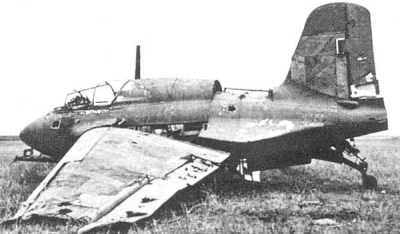
Planes of Fame Air Museum in Chino, California has a complete original captured Imperial Japanese Navy J8M1 on display. It was 1 of 2 bought back from Japan in 1945 for evaluation by the USAAF and US Navy respectively (neither were eventually flown). The other J8M1 was scrapped by the US Navy sometime after October 1946 – it is a pity they didn’t keep that one too but as we all know too well, it was not unusual for such captured aircraft to be disposed of once testing and inspections were completed! Today we just have to be thankful for what remains today in museums and flying as warbirds.
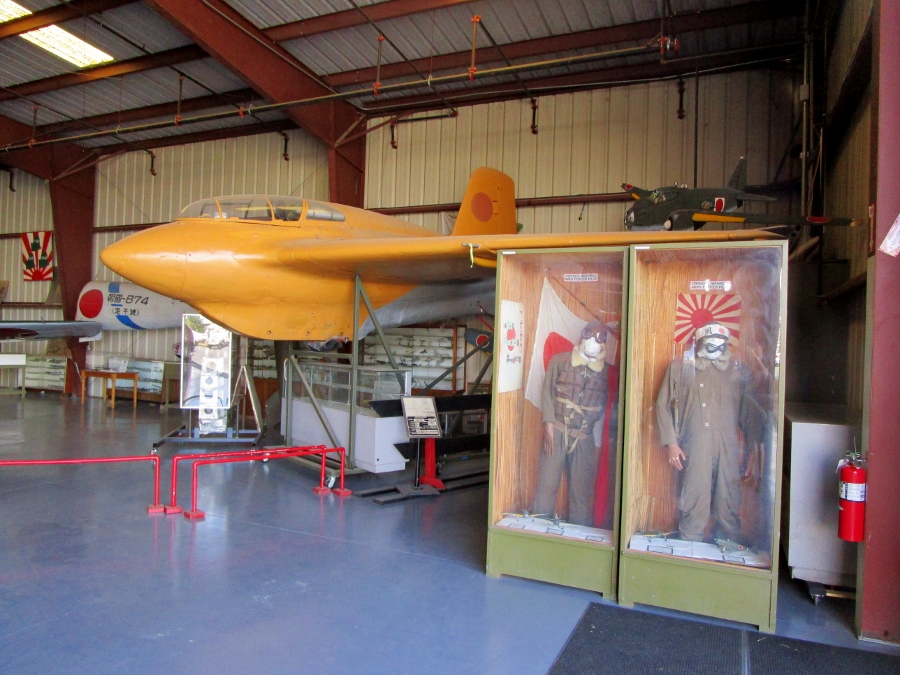
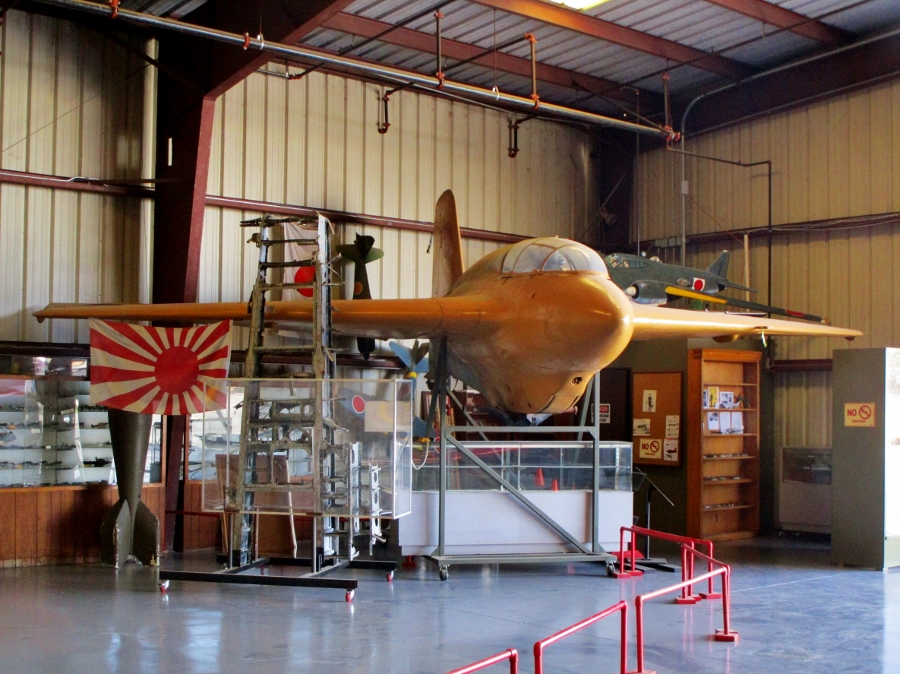
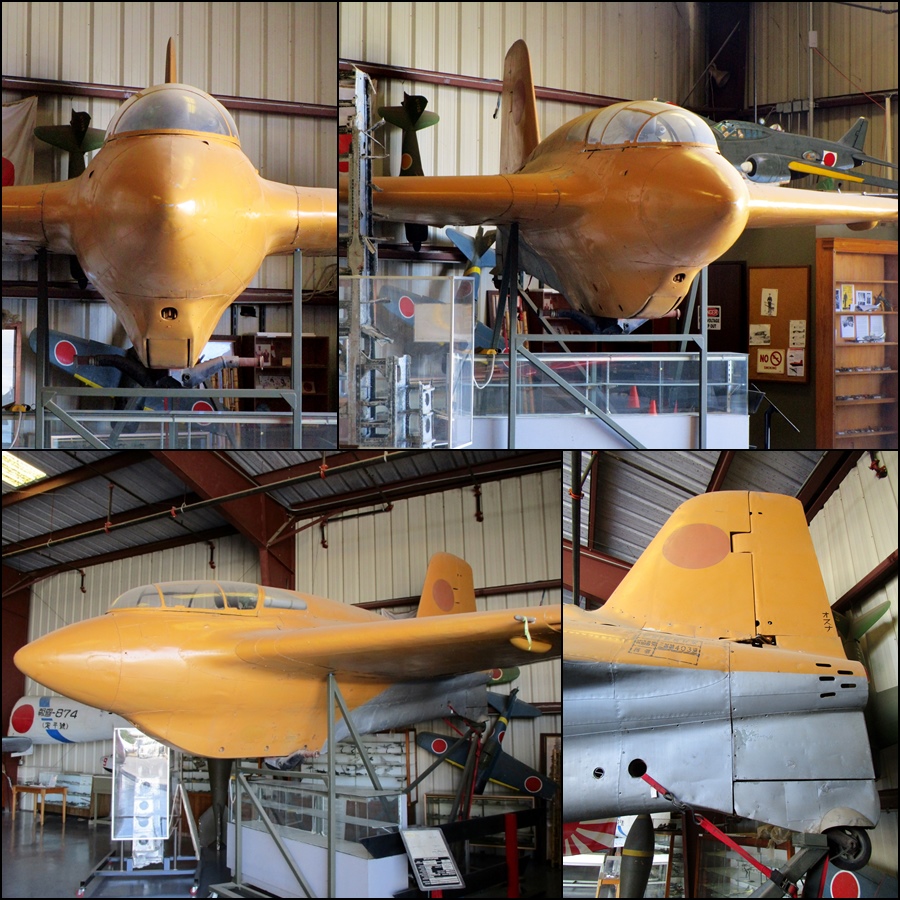


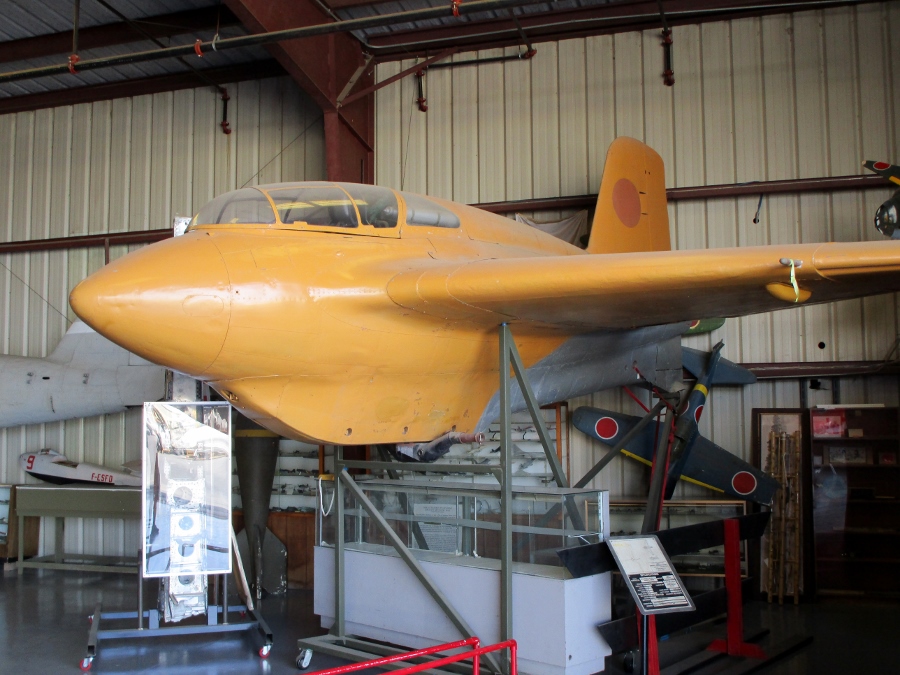
The Mitsubishi Heavy Industry Museum at the Komaki Plant near Nagoya, Japan has an interesting J8M1 on display. In the 1960’s the incomplete, damaged J8M1 airframe was discovered in a cave in Japan (a bit different from the normal “barn find”). Until 1999 it was displayed as it was at a Japanese Air Self Defense Forces (JASDF) base near Gifu. Mitsubishi began a restoration project in 1999 and today it is on display at the Mitsubishi museum in a light green livery but only the fuselage is original, the remainder is made up of replica parts.
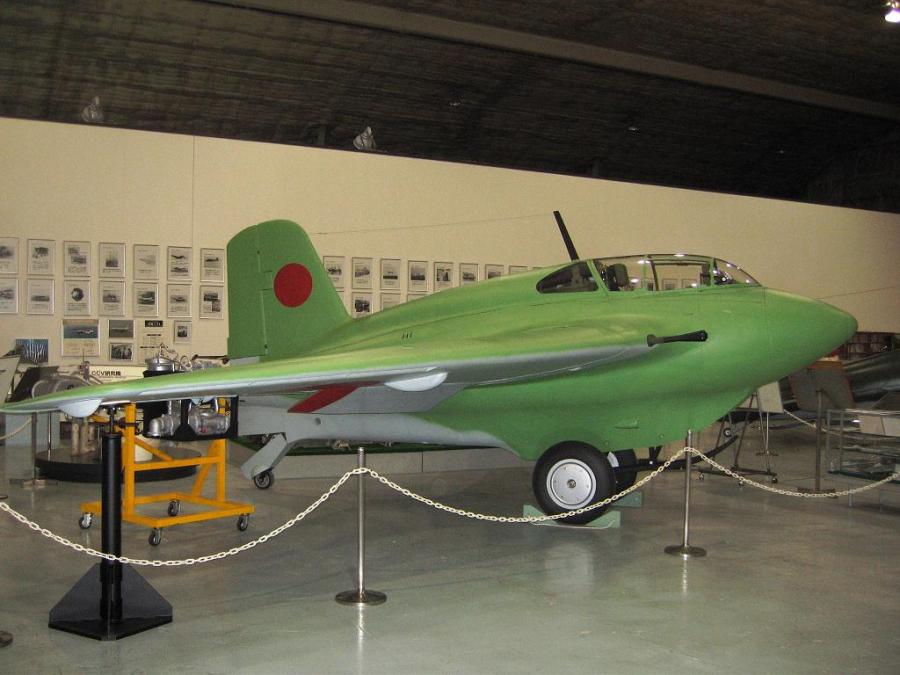
The Mitsubishi J8M1 Shusui provides another interesting yet flawed chapter in aviation history. Rocket powered aircraft were still experimented with in the early years of the Cold War but ultimately jet technology proved to be the way to go forward.
References:
Combined Fleet – Mitsubishi J8M
Japanese Secret Projects: Experimental Aircraft of the IJA and IJN 1939-1945 – Edwin M. Dyer, 2009
Military Factory – Mitsubishi J8M
Pacific Wrecks – Mitsubishi J8M1 (Ki-200)
Rocketing Into the Future: The History and Technology of Rocket Planes – Michel van Pelt, 2012
Tails Through Time – Mitsubish J8M

The Shusui was a tough deal, handing over $8M for a plane they basically had to develop from scratch. Great article.
LikeLike
Thanks. Yes the fate of war and political dealings can be very fickle!
LikeLiked by 1 person
Another great post – thanks for sharing! I guess we have to be thankful on many levels that this technology wasn’t available to the Japanese earlier – to me the obvious solution to the problems they had with powered flight and landing was to adopt them as kamakaze weapons, with tragic outcomes for the pilot and his family, along with the losses caused – with their own grief and tragedy for victims and families – on their targets.
As an aside, the U-boat traffic between Germany and Japan was slight but important – there is a story here in NZ of U-862, which ran the blockade from Norway in late 1944 and reached Singapore with a cargo of mercury and other materials the Japanese needed. Its return to German waters with an equivalent cargo of Nazi necessities was delayed by a venture into Australasian waters, including a night cruise, on the surface, past my home town of Napier. The crew could scarcely believe what they saw: a town in full peacetime rig, with what they thought were dancers in sea-front cafes (I think it was skating on a rink on the foreshore – I checked…). They attacked a ship that left Napier harbour, the torpedo missed, and were recalled to Singapore, where the boat was then drawn into the IJN. I later spoke to the daughter of one of the crew, who told me her Dad had been relieving himself off the side, saw the torpedo track and reported it – only to be rubbished, because no enemy could possibly be in New Zealand waters at this stage! Off-topic I know… but I wanted to share… There are many wonderful stories of this nature that haven’t been told… 🙂
LikeLiked by 1 person
Thanks. It is quite fascinating how far they travelled in U Boats across all oceans. There are plenty of sunken ships along the US Atlantic coast that were nice backlit targets from lights on the coast!
LikeLiked by 1 person
Fascinating post. I knew the Japanese and Germans had been sharing secrets and technologies, I didn’t realise however, that they had got this model and were making some progress with it.
LikeLiked by 1 person
Thanks. Yes they experimented with a number of German aircraft but this was the main one that went into full development (they did also build a jet fighter that was similar in appearance to the Me 262 but it was not a licence built variant – Nakajima Kikka – it was smaller and had straight wings)
LikeLiked by 1 person
It’s certainly a fascinating area of aviation development.
LikeLiked by 1 person
Sure is. Luckily all too late
LikeLike
Hi, what source did you use to find out that the J8M1/Ki-200 may have had the same 7.5 minutes endurance as the Me-163? It would be very helpful for me to know if they would have actually been capable of powered flight for longer than 5 minutes.
LikeLike
Hi Tristan, that was a slight typo which I have corrected. Most references say 5.5 minutes for the J8M1 and around 7 for the Ki-200
LikeLike
Thanks for the reply. the Ki-200 is featured in a simulator game called War Thunder. I noticed that the Ki-200 as modeled in the game was using the J8M1’s fuel load and Type 5 cannons and I am trying to prove to the developers the difference between the Ki-200 and J8M1 so that they update the endurance. The only good source I have found is a book called Japanese Secret Projects: Experimental Aircraft of the IJA and IJN 1939-1945. If I can find one more reference for the 7 minutes figure, the developers might change it, but I am having some trouble.
LikeLike
Ah I see, yes most only mention the J8M1. Wikipedia has a comparison table between the characteristics of both. It seems fuel estimates are often overlooked in books I have read with this aircraft.
LikeLike
I think Wikipedia is using the book I mentioned as a source, but in the book itself it shows that the Ki-200 indeed still can reach 900kmh, so unsure where they got those other numbers. I am thinking there must be another book out there that goes into more detail on the Ki-200’s 7 minute endurance. I am unsure how they estimated 7 minutes because of its large difference from 5 minutes 30 seconds. Perhaps the army’s version had a more efficient motor or something. Even if I find another reference that the Ki-200 had an estimated 7 minutes, I would still like to know why it would have that much more than the J8M1.
LikeLike
Yes the motor efficiency and capacity must have varied. It may be that the 7 mins was what was envsioned for the larger Ki-202 that never left the drawing board and may have resulted in confusion. Does the book have much info on Ki-200 testing?
LikeLike
The book mentions very little about the Ki-200 because the Ki-200 design never got fitted with its engine before the war ended even though the Army was beginning to start on that after the J8M1 test flight crash. The book mentions that the Navy used the KR10 motor from the Yamakita group, while the Army was going to fit the Ki-200 with the KR10 motor created by the Matsumoto group. Because both the J8M1 and the Ki-200 have the same fuel capacity in the specifications, I believe the Army must have found more efficiency in the Matsumoto motor which is not directly mentioned in the book.
You can read the book online here – https://www.scribd.com/doc/52904049/Japanese-Secret-Projects-Experimental-Aircraft-1939-1945 starting at page 96
The Ki-202 definitely had more than 7 minutes of endurance, it is mentioned in many sources including the book that it would have had an estimated 10 minutes 28 seconds endurance. I also found out that the Ki-200 would be fitted with Ho-155 30mm cannons in contrast to the Type 5 cannons on the J8M1. It seems most of the Army planes used the ‘Ho’ cannons and Navy would use ‘Type’ cannons.
LikeLiked by 1 person
Thanks. Yes that’s correct with the guns. Interestingly the dimensions of the Ki-200 are slightly smaller than the J8M
LikeLike
The Ho-105 cannons were apparently lighter than the Type 5 cannons but the empty weight of the Ki-200 is listed as more than the J8M1 and the book states they carried the same amount of fuel so that cannot have made any difference. It is an interesting dilemma!
LikeLike
The length of the Ki-200 I think is similar to the 163, I wonder if they intended to use a different nosecone or if their KR 10 motor was actually that different. I cannot figure it out myself.
LikeLike
Its a mystery
LikeLike